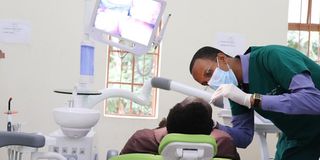Visit dentist for regular checkups

What you need to know:
According to a survey by the market research platform DentaVox, the most important factors of dental prevention for patients are regular check-ups and teeth cleaning, taking a large majority of almost half the answers in the findings
With the growing interest in preventive dentistry, replacing the old method of drill and fill, a question arises: Does it negatively affect a dentist’s income? Considering that dental treatments can oftentimes be quite costly, this certainly rings true. But is it real? To determine whether this is real or not, it is essential to first take a closer look at what preventive dentistry covers.
According to a survey by the market research platform DentaVox, the most important factors of dental prevention for patients are regular check-ups and teeth cleaning, taking a large majority of almost half the answers in the findings. Oral care routine and products come in second with around a third of respondents. And while both checkups and teeth cleaning procedures cost zero to none for any dentist, they contribute to a small, but healthy regular income flow.
Having in mind the poor access to dental insurance for people all over the world, when it comes to who foots the bills for these routine, preventive services, it is quite often the patients themselves (in 70 per cent of respondents), as seen in the results of the same survey. Sadly, this is also the case when it comes to expensive treatments, which insurance covers only a small portion of. That is why it is not out of the blue to see that patients will be less likely to seek treatment for major issues if they cannot afford it, which leads to an irregular and decreased patient flow for dentists.
Summing it up, while drill & fill dentistry does seem to pay more in the short-term, it also creates more space between appointments and the practice. This translates into less income in the long-run, especially for dentists servicing low-income populations, who cannot afford them.
That is why it is essential for dentists to set up a regular income flow through regular check-ups and cleanings in order to increase their overall revenue. Moreover, the common practice of offering membership plans - basic dental services coverage against monthly fees - is also here to support income diversification.
Naturally, this doesn’t mean that all major expensive procedures are out of the picture. They will still be there to provide an additional boost to a dentist’s bottom line.
So how can a dentist be sure, they will be able to set up a regular income flow from preventive dentistry? Fortunately, with the rise of digital technology, there are tools already available that allow us to take a look under the hood and see the specifics to decide for ourselves.
Enter, for example, Dentacoin Assurance - a novel method for fostering prevention in exchange for small monthly premiums paid out directly from patient to dentist. The website’s calculator makes it easy for dentists to imagine their possible income increase, taking into account the number of patients the dentist serves, their qualifications, and the average premiums of the country they reside in.
This gives an excellent overview for dentists who are interested in setting up such a programme and steady income flow based on prevention.
Petar Stoykov,
Dentist




